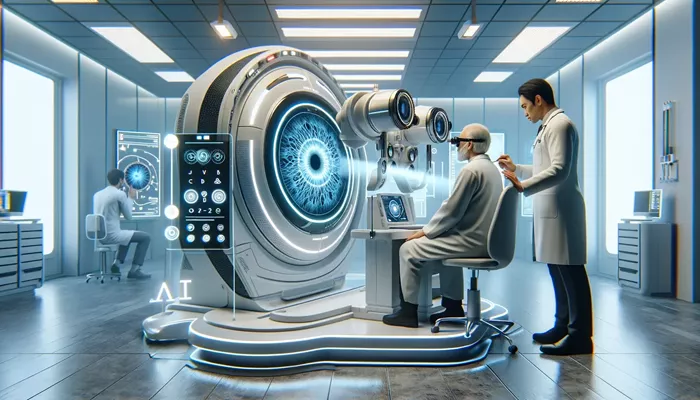Artificial intelligence (AI) is rapidly reshaping healthcare, with vision care emerging as a key area of advancement. From early detection of eye conditions to personalized treatment plans, AI is improving the efficiency, accessibility, and accuracy of eye care. Here’s how AI is transforming the field of vision care:
1. AI Enhances Early Detection of Eye Conditions
AI-powered diagnostic tools are revolutionizing the early detection of common eye diseases. By using advanced image recognition technology, AI systems can analyze retinal scans and other eye imaging with exceptional precision. These tools excel in identifying conditions such as diabetic retinopathy, glaucoma, and age-related macular degeneration during routine screenings. Early diagnosis enables timely interventions, significantly reducing the risk of vision loss that could occur with delayed treatment.
2. Personalized Vision Correction Solutions
AI is also driving innovation in personalized vision correction. By analyzing an individual’s eye structure, lifestyle habits, and visual needs, AI systems can recommend customized prescriptions for glasses and contact lenses. These advanced algorithms take into account factors such as screen time, work environment, and daily routines, ensuring that vision correction is optimized for comfort and performance. This personalized approach helps reduce eye strain and improves visual comfort throughout the day.
3. Real-Time Vision Assistance for Impaired Users
For individuals with visual impairments, AI-powered devices offer real-time assistance to improve independence. These technologies can describe surroundings, read text aloud, and identify objects or faces, enabling users to navigate daily life more confidently. AI-driven assistive devices improve over time, learning from user interactions to offer more accurate and tailored support. This technology is especially beneficial for those with progressive vision conditions, offering a lifeline in managing daily tasks.
4. Efficient Monitoring and Treatment Adjustments
AI excels in tracking the progress of vision treatments, allowing for timely adjustments. By monitoring changes in vision, medication responses, and lifestyle factors, AI systems help eye care professionals make data-driven decisions about treatment plans. These technologies analyze trends and patterns in a patient’s condition, providing valuable insights to optimize treatment strategies. This approach not only leads to better health outcomes but also maximizes the efficiency of care.
5. Combating Digital Eye Strain
With the rise in digital device usage, AI is playing a key role in managing and preventing digital eye strain. Smart systems monitor factors such as screen time, viewing distances, and environmental conditions, offering personalized recommendations to promote eye health. These tools can adjust screen brightness, remind users to take breaks, and suggest optimal viewing angles based on individual habits. In an increasingly digital world, these proactive measures help preserve long-term eye health.
6. Leveraging Big Data for Smarter Vision Care
AI systems continuously improve by learning from vast amounts of eye health data. By analyzing this information, AI can detect subtle patterns and predict potential issues, leading to more accurate diagnoses and treatment plans. The integration of privacy-protected data from eye care providers further enhances the sophistication of these systems, allowing for more targeted and effective interventions.
7. AI Complements Traditional Eye Care
While AI is a powerful tool, it works best in conjunction with traditional eye care practices. AI technologies support the expertise of ophthalmologists and optometrists, offering valuable insights that help guide treatment decisions. This collaboration between AI and healthcare professionals ensures that patients receive comprehensive care that combines technological innovation with the human touch.
8. Improving Accessibility and Affordability
AI-driven solutions are also making vision care more accessible, especially for underserved populations. Remote screening and monitoring capabilities allow individuals in remote or underserved areas to receive eye care without having to visit a clinic. Furthermore, these technologies can reduce the cost of certain eye care services, making regular vision screenings and treatments more affordable. By increasing access and affordability, AI is helping prevent vision problems through earlier detection and intervention.
9. Emerging of AI in Vision Care
As research into AI in healthcare continues to evolve, new applications are emerging. Advanced imaging techniques, more refined prediction models, and innovative treatment options are on the horizon, offering the potential to further revolutionize eye care. These advancements promise to provide even more accurate diagnoses and personalized treatment plans, ultimately improving patient outcomes.
10. The Ongoing Importance of Professional Monitoring
Despite the promising benefits of AI, regular professional eye exams remain critical. AI technologies are most effective when integrated into a comprehensive eye care strategy that includes routine check-ups with an eye care professional. Regular monitoring ensures that AI-powered tools continue to meet individual patient needs, while also tracking any changes in vision health over time.
The Expanding Role of AI in Eye Health
As AI technology continues to advance, its impact on vision care is set to grow. These innovations are paving the way for smarter, more efficient, and personalized eye care, improving accessibility and reducing the burden of vision-related diseases. As individuals and healthcare providers embrace these new tools, the future of vision care looks brighter than ever—offering hope for improved eye health outcomes across the globe.
Related topic:
Maximize Your FSA for Vision Care in 2025
EU to Investigate Ozempic’s Link to Blindness Risk
Dr Agarwal’s Eye Hospital Unveils Advanced Laser Technology

